

Objective-C Automatic Reference Counting (ARC) Technical Reference – Intel® HTML5 App Porter Tool - BETA. , 2013.
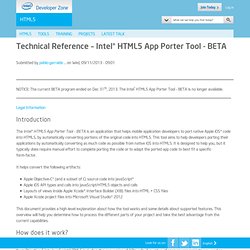
The Intel HTML5 App Porter Tool - BETA is no longer available. Legal Information Introduction The Intel® HTML5 App Porter Tool - BETA is an application that helps mobile application developers to port native Apple iOS* code into HTML5, by automatically converting portions of the original code into HTML5. This tool aims to help developers porting their applications by automatically converting as much code as possible from native iOS into HTML5. It helps convert the following artifacts: Historique. Categories Objective-C - Wikipedia, Objective-C source code program files usually have .m filename extensions, while Objective-C header files have .h extensions, the same as for C header files.

History[edit] Objective-C was created primarily by Brad Cox and Tom Love in the early 1980s at their company Stepstone.[2] Both had been introduced to Smalltalk while at ITT Corporation's Programming Technology Center in 1981. The earliest work on Objective-C traces back to around that time.[3] Cox was intrigued by problems of true reusability in software design and programming. He realized that a language like Smalltalk would be invaluable in building development environments for system developers at ITT. However, he and Tom Love also recognized that backward compatibility with C was critically important in ITT's telecom engineering milieu.[4] Cox began writing a pre-processor for C to add some of the capabilities of Smalltalk. Popularization through NeXT[edit] Syntax[edit] Développer pour Iphone/Ipod Touch : Cocao (Objectif-C 2.0) + Iph. Depuis quelques jours seulement, j’ai commencé par me documenter sur le développement pour Iphone (et Ipod Touch).
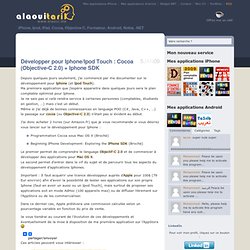
Ma premiere application que j’espère apparaitra dans quelques jours sera le plan comptable optimisé pour Iphone. Je ne sais pas si celà rendra service à certaines personnes (comptables, étudiants en gestion, …) mais c’est un début. Pierre Chatelier: De C++ à Objective-C - Club des décideurs et p. Ce document est un guide de passage de C++ à Objective-C. Il existe plusieurs documentations soucieuses d'enseigner le modèle objet via Objective-C, mais aucune à ma connaissance n'est destinée aux codeurs expérimentés en C++, désirant se renseigner sur les concepts du langage pour les comparer à ce qu'ils connaissent déjà.
Le langage Objective-C m'avait semblé au premier abord un obstacle plutôt qu'un tremplin à la programmation avec Cocoa (cf. section 1 page suivante) : il est si peu répandu que je ne comprenais pas son intérêt face à un C++ puissant, efficace et maîtrisé. Il a donc fallu longtemps pour que je comprenne qu'il était au contraire un réel concurrent grâce à la richesse des concepts qu'il propose. Ce document ne se présente pas comme un didacticiel mais comme une référence de ces concepts. Article lu 3416 fois. version 2.1 ajouts d'explications pour les blocks. Google Objective-C Style Guide. Unlike C++, Objective-C doesn't have a way to differentiate between public and private methods—everything is public.
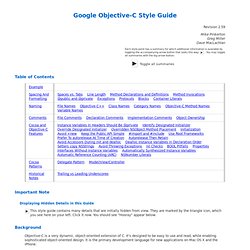
As a result, avoid placing methods in the public API unless they are actually expected to be used by a consumer of the class. This helps reduce the likelihood they'll be called when you're not expecting it. This includes methods that are being overridden from the parent class. For internal implementation methods, use a category defined in the implementation file as opposed to adding them to the public header. #import "GTMFoo.h" @interface GTMFoo (PrivateDelegateHandling) - (NSString *)doSomethingWithDelegate; // Declare private method @end @implementation GTMFoo (PrivateDelegateHandling) ... - (NSString *)doSomethingWithDelegate { // Implement this method } ...
If you are using Objective-C 2.0, you should instead declare your private category using a class extension, for example: @interface GMFoo () { ... } Again, "private" methods are not really private. Mac Dev Center: Coding Guidelines for Cocoa: Introduction to Cod. C and Objective C Compared. Volume Number: 13 (1997) Issue Number: 3 Column Tag: Rhapsody By Michael Rutman, independent consultant.
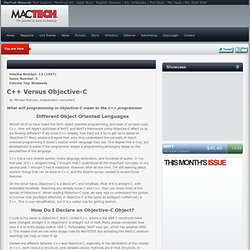
Objective C. Introduction à l'Objective-C. iOS Dev Tuto.
Documenting Objective-C with Doxygen Part I. When working on a projects, whether they consist of a single file or hundreds of classes, documentation is a requirement.
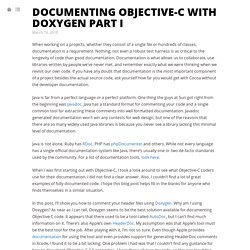
Nothing, not even a robust test harness is as critical to the longevity of code than good documentation. Documentation is what allows us to collaborate, use libraries written by people we’ve never met, and remember exactly what we were thinking when we revisit our own code. If you have any doubt that documentation is the most important component of a project besides the actual source code, ask yourself how far you would get with Cocoa without the developer documentation. Java is far from a perfect language or a perfect platform. One thing the guys at Sun got right from the beginning was Javadoc. Java is not alone. Documenting Objective-C with Doxygen Part II. In part I I covered how to comment your code with javdoc style comments that can be extracted into html documents or other types of output.
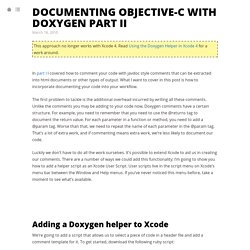
What I want to cover in this post is how to incorporate documenting your code into your workflow. The first problem to tackle is the additional overhead incurred by writing all these comments. Unlike the comments you may be adding to your code now, Doxygen comments have a certain structure. For example, you need to remember that you need to use the @returns tag to document the return value. For each parameter in a function or method, you need to add a @param tag. Luckily we don’t have to do all the work ourselves. Adding a Doxygen helper to Xcode We’re going to add a script that allows us to select a piece of code in a header file and add a comment template for it.
Doxygen.rb Once you have the script downloaded, take the following steps: Open the script and copy the contents.In Xcode, select the Scripts > Edit User Scripts… menu. Doxygen_build.sh.